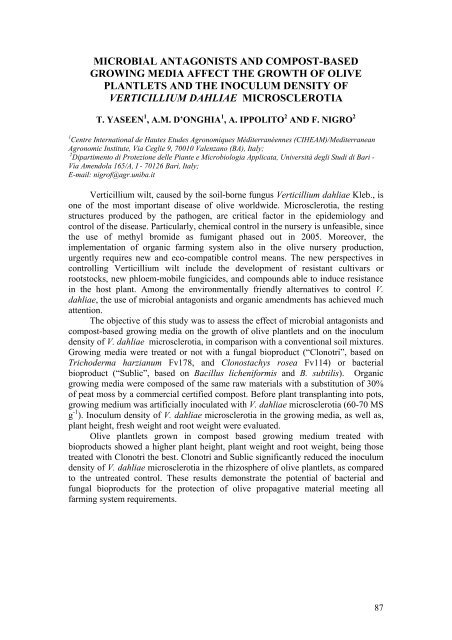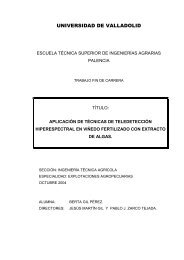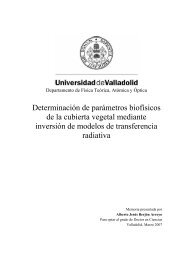10th INTERNATIONAL VERTICILLIUM SYMPOSIUM 16-20 ...
10th INTERNATIONAL VERTICILLIUM SYMPOSIUM 16-20 ...
10th INTERNATIONAL VERTICILLIUM SYMPOSIUM 16-20 ...
You also want an ePaper? Increase the reach of your titles
YUMPU automatically turns print PDFs into web optimized ePapers that Google loves.
MICROBIAL ANTAGONISTS AND COMPOST-BASEDGROWING MEDIA AFFECT THE GROWTH OF OLIVEPLANTLETS AND THE INOCULUM DENSITY OF<strong>VERTICILLIUM</strong> DAHLIAE MICROSCLEROTIAT. YASEEN 1 , A.M. D’ONGHIA 1 , A. IPPOLITO 2 AND F. NIGRO 21 Centre International de Hautes Etudes Agronomiques Méditerranéennes (CIHEAM)/MediterraneanAgronomic Institute, Via Ceglie 9, 70010 Valenzano (BA), Italy;2 Dipartimento di Protezione delle Piante e Microbiologia Applicata, Università degli Studi di Bari -Via Amendola <strong>16</strong>5/A, I - 70126 Bari, Italy;E-mail: nigrof@agr.uniba.itVerticillium wilt, caused by the soil-borne fungus Verticillium dahliae Kleb., isone of the most important disease of olive worldwide. Microsclerotia, the restingstructures produced by the pathogen, are critical factor in the epidemiology andcontrol of the disease. Particularly, chemical control in the nursery is unfeasible, sincethe use of methyl bromide as fumigant phased out in <strong>20</strong>05. Moreover, theimplementation of organic farming system also in the olive nursery production,urgently requires new and eco-compatible control means. The new perspectives incontrolling Verticillium wilt include the development of resistant cultivars orrootstocks, new phloem-mobile fungicides, and compounds able to induce resistancein the host plant. Among the environmentally friendly alternatives to control V.dahliae, the use of microbial antagonists and organic amendments has achieved muchattention.The objective of this study was to assess the effect of microbial antagonists andcompost-based growing media on the growth of olive plantlets and on the inoculumdensity of V. dahliae microsclerotia, in comparison with a conventional soil mixtures.Growing media were treated or not with a fungal bioproduct (“Clonotri”, based onTrichoderma harzianum Fv178, and Clonostachys rosea Fv114) or bacterialbioproduct (“Sublic”, based on Bacillus licheniformis and B. subtilis). Organicgrowing media were composed of the same raw materials with a substitution of 30%of peat moss by a commercial certified compost. Before plant transplanting into pots,growing medium was artificially inoculated with V. dahliae microsclerotia (60-70 MSg -1 ). Inoculum density of V. dahliae microsclerotia in the growing media, as well as,plant height, fresh weight and root weight were evaluated.Olive plantlets grown in compost based growing medium treated withbioproducts showed a higher plant height, plant weight and root weight, being thosetreated with Clonotri the best. Clonotri and Sublic significantly reduced the inoculumdensity of V. dahliae microsclerotia in the rhizosphere of olive plantlets, as comparedto the untreated control. These results demonstrate the potential of bacterial andfungal bioproducts for the protection of olive propagative material meeting allfarming system requirements.87




